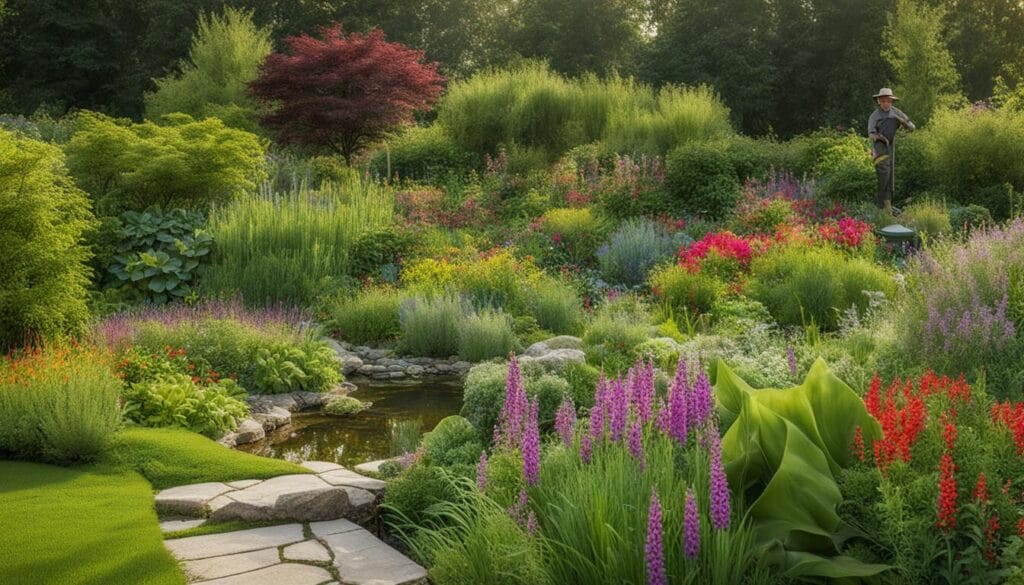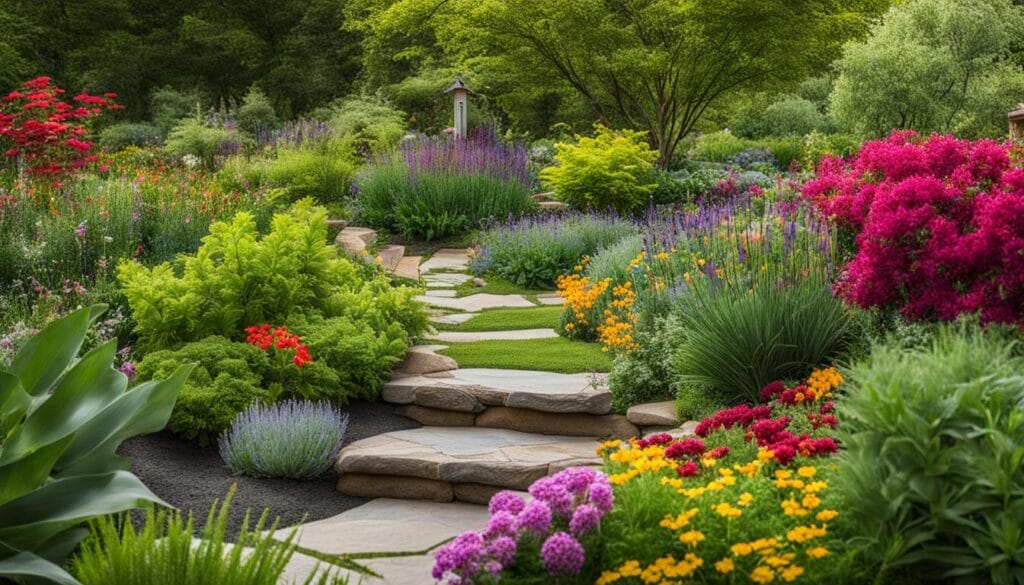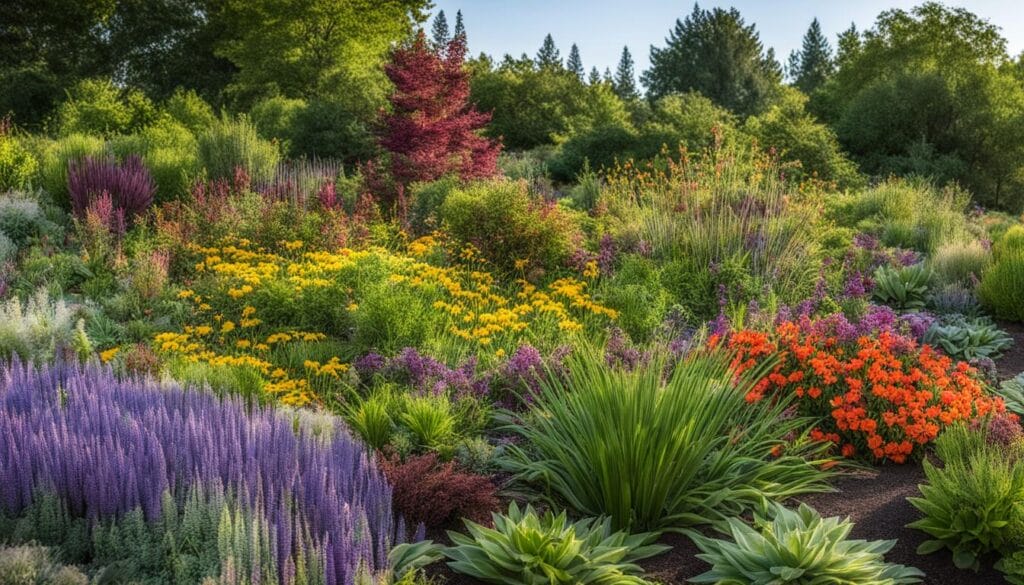Welcome to our guide on maintaining native plant gardens! Incorporating native plants into your garden design not only benefits the environment but also reduces the amount of time and effort you’ll need to spend on maintenance. Native plants are well adapted to the local climate and soil conditions, making them hardier and more self-sufficient. In this section, we will provide you with expert tips and advice on how to care for your native plant garden effectively.
Key Takeaways:
- Choose native plants that are suited to your local climate and soil conditions.
- Water your native plant garden deeply and infrequently, allowing the soil to dry out between watering sessions.
- Apply a layer of organic mulch around your plants to retain moisture, suppress weeds, and regulate soil temperature.
- Prune your native plants regularly to maintain their shape and remove any dead or diseased branches.
- Monitor for pests and diseases and take appropriate action to prevent or control any issues.
By following these maintenance tips, you can ensure that your native plant garden thrives and continues to contribute to the beauty and biodiversity of your outdoor space.
Benefits of Using Native Plants in Landscape Design
When it comes to landscaping, using native plants offers numerous benefits for both the environment and homeowners. These plants are not only environmentally friendly but also require minimal maintenance, while at the same time promoting increased biodiversity and adding a unique aesthetic appeal to any garden.
Environmental Friendliness
One of the key advantages of using native plants is their environmental friendliness. These plants are naturally adapted to the local climate and soil conditions, reducing the need for excessive watering, fertilizers, and pesticides. By incorporating native plants in your landscape design, you can significantly reduce water usage and minimize the use of harmful chemicals, contributing to a more sustainable and eco-friendly approach to gardening.
Low Maintenance Requirements
Another significant benefit of native plants is their low maintenance requirements. These plants are well-suited to the local conditions, making them more resilient and self-sufficient. Unlike non-native plants, native plants do not require frequent watering, fertilization, or pesticide use. This not only saves homeowners time and effort but also reduces the overall costs associated with garden maintenance.
Increased Biodiversity and Aesthetic Appeal
Native plants play a vital role in promoting increased biodiversity in your garden. They provide essential habitats and food sources for local wildlife, attracting butterflies, birds, and bees. By incorporating native plants, you can help establish diverse and robust ecosystems in your garden, contributing to the conservation of native species. In addition to their environmental benefits, native plants also offer a unique and natural beauty that enhances the aesthetic appeal of any landscape design. Their colorful flowers and lush foliage create a sense of place and elevate the overall visual impact of your outdoor space.
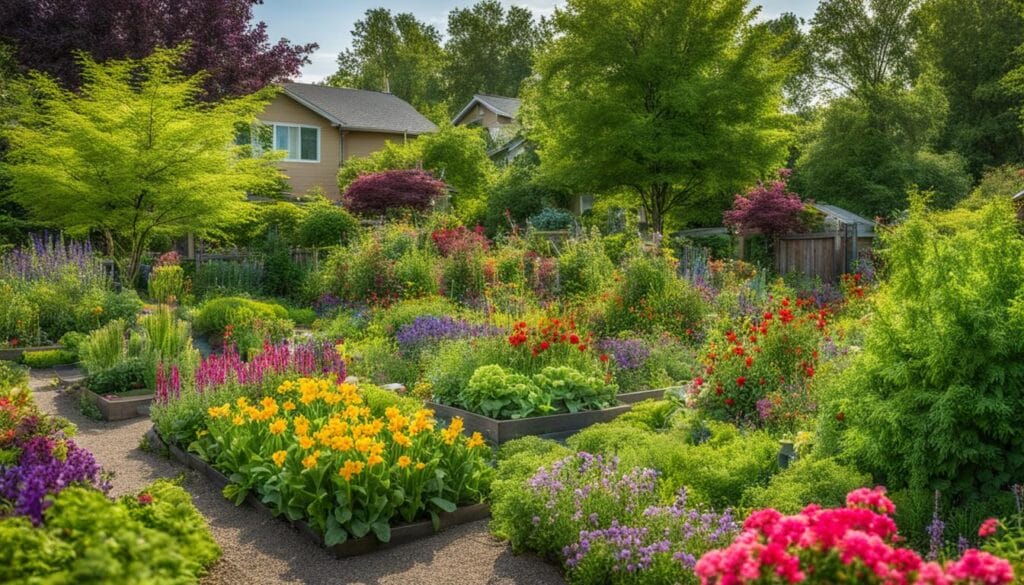
| Benefits of Using Native Plants in Landscape Design | Summary |
|---|---|
| Environmental Friendliness | Reduced water usage and minimized chemical use |
| Low Maintenance Requirements | Saves time, effort, and money on maintenance tasks |
| Increased Biodiversity and Aesthetic Appeal | Provides habitats for wildlife and enhances the visual appeal of the garden |
Incorporating native plants into your landscape design not only benefits the environment but also offers a practical and visually pleasing solution for homeowners. By embracing the benefits of using native plants, you can create a sustainable and low-maintenance garden that supports local ecosystems and adds a touch of natural beauty to your outdoor space.
Environmental Benefits of Native Plant Gardens
Creating a native plant garden in your backyard not only adds beauty to your outdoor space but also provides numerous environmental benefits. These gardens are designed with plants that are naturally adapted to the local climate and soil, resulting in reduced water usage and a smaller carbon footprint. Let’s explore the environmental advantages of native plant gardens in more detail.
Reduced Water Usage
Native plant gardens require less water compared to non-native gardens. Native plants have evolved to thrive in the local climate, which means they are more drought-tolerant and can survive on natural rainfall. By incorporating these plants into your garden, you can significantly reduce the amount of water needed for irrigation, contributing to water conservation efforts.
Carbon Footprint Reduction
Native plant gardens play a crucial role in reducing our carbon footprint. They require minimal chemical inputs such as fertilizers and pesticides, which means fewer harmful substances are released into the environment. Additionally, native plants help sequester carbon dioxide from the atmosphere, acting as a natural carbon sink and mitigating climate change.
Erosion Prevention and Healthy Soil
Native plants have extensive root systems that help anchor the soil and prevent erosion. Their deep-reaching roots also improve soil structure, allowing better absorption of rainfall and reducing the risk of runoff. Moreover, these plants enhance soil health by enriching it with organic matter and nutrients, resulting in a thriving ecosystem for beneficial microorganisms and promoting overall soil fertility.
| Environmental Benefits of Native Plant Gardens |
|---|
| Reduced water usage |
| Carbon footprint reduction |
| Erosion prevention and healthy soil |
By embracing native plants in your garden, you contribute to a more sustainable and environmentally friendly ecosystem. The reduced water usage, carbon footprint reduction, and erosion prevention not only benefit your immediate surroundings but also have a positive impact on the larger environment. Make a difference by creating a native plant garden and play your part in conserving natural resources while enjoying the beauty of nature.
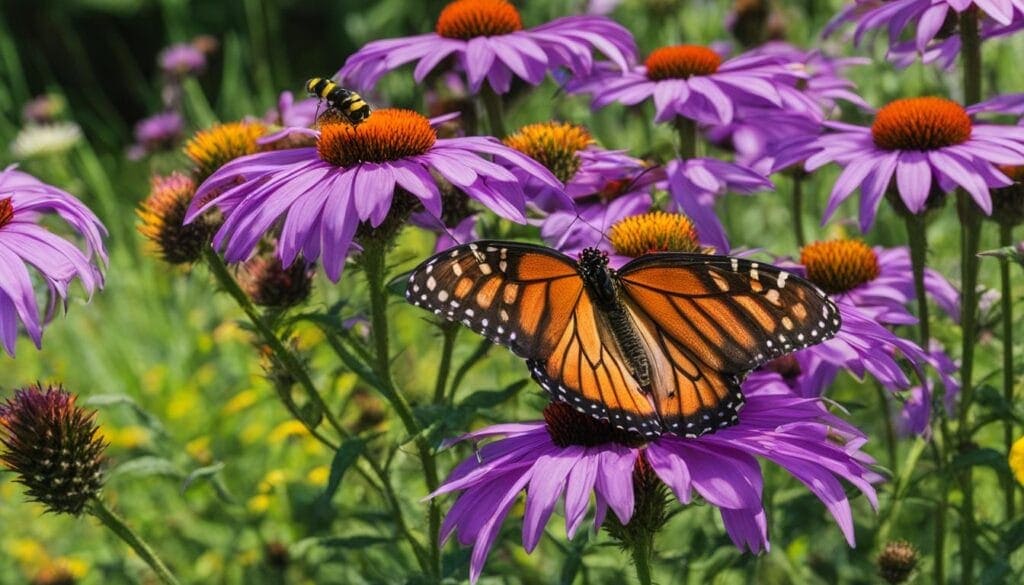
Low Maintenance Requirements of Native Plant Gardens
When it comes to creating a beautiful and sustainable garden, native plant gardens are hard to beat. Not only do they bring a unique beauty to your outdoor space, but they also require minimal maintenance. Native plants are naturally adapted to the local climate, making them more resilient and self-sufficient. This means less watering, fertilization, and pesticide use, saving you time and money on upkeep tasks.
Unlike non-native plants, which may struggle to thrive in unfamiliar conditions, native plants have evolved to flourish in the local environment. They are better equipped to withstand drought, extreme temperatures, and pests, reducing the need for constant attention. This makes native plant gardens an excellent choice for busy homeowners or those looking to minimize their environmental impact through sustainable gardening practices.
When designing your native plant garden, consider grouping plants with similar maintenance requirements together. This will help create a cohesive and visually appealing landscape while also making it easier to care for your plants. Selecting a variety of native species can also help promote biodiversity and attract pollinators, further enhancing the overall health and beauty of your garden.
| Low Maintenance Tips for Native Plant Gardens |
|---|
| Choose native plants that are adapted to your specific region and soil conditions. |
| Group plants based on their water and sunlight needs to minimize irrigation efforts. |
| Apply a layer of mulch around your plants to retain moisture, suppress weeds, and improve soil health. |
| Regularly monitor your garden for pests or diseases, and take appropriate action if necessary. |
| Allow native plants to naturally scatter seeds and self-propagate, reducing the need for replanting. |
| Perform periodic maintenance tasks, such as removing dead or diseased plants, pruning, or dividing overcrowded plants. |
By following these low maintenance tips, you can enjoy the beauty and benefits of a native plant garden without the hassle of constant upkeep. Let nature take its course and watch as your garden thrives with minimal intervention.
Promoting Biodiversity with Native Plant Gardens
Native plant gardens are not only visually appealing but also play a crucial role in promoting biodiversity. By incorporating native plants into your garden, you create essential habitats and food sources for a variety of wildlife, contributing to the overall ecosystem. The increased biodiversity in native plant gardens helps support the conservation of native species and prevents the introduction of invasive species.
Attracting wildlife is one of the key benefits of native plant gardens. Native plants provide resources such as nectar, pollen, and seeds that attract butterflies, bees, and birds. These plants serve as important hosts for butterfly caterpillars and attract pollinators, facilitating the reproduction and survival of various species. By creating a diverse and welcoming environment, you can enjoy the presence of wildlife in your garden while also supporting their well-being.
Native plant gardens also provide essential habitats for wildlife. The dense foliage and structure of native plants offer shelter and nesting opportunities for birds and small animals. Additionally, the presence of native plants attracts a diverse range of insects, which in turn provides a vital food source for birds and other insectivorous animals. By cultivating a native plant garden, you are helping to preserve and protect the natural habitats that many species rely on.
Furthermore, native plant gardens contribute to the availability of food sources for wildlife. Native plants have co-evolved with local animals, resulting in a mutual relationship where plants provide food and animals assist in spreading seeds. The fruits, berries, and seeds produced by native plants offer sustenance to many species including birds, mammals, and insects. By incorporating native plants into your garden, you ensure that wildlife has access to the food they need to thrive.
Quotes
“Native plant gardens are like a buffet for wildlife. By providing a diverse range of native plants, you create an oasis for birds, butterflies, and other creatures to find food and shelter.” – Jane, avid gardener
Table: Native Plants and Wildlife Attraction
| Native Plant Species | Wildlife Attracted |
|---|---|
| Butterfly Weed (Asclepias tuberosa) | Butterflies, bees |
| Purple Coneflower (Echinacea purpurea) | Butterflies, bees, birds |
| Eastern Redbud (Cercis canadensis) | Birds, butterflies |
| Switchgrass (Panicum virgatum) | Birds |
By selecting native plant species that attract specific wildlife, you can create a garden that caters to the needs of your local ecosystem. Consider consulting a local native plant nursery or a gardening expert to determine the best native plant species for attracting wildlife in your area.
Creating a garden that promotes biodiversity not only benefits the environment but also provides a rewarding and enriching experience for you as a gardener. So, go ahead and embrace native plants to transform your garden into a vibrant and thriving haven for wildlife!
The Aesthetic Appeal of Native Plant Gardens
Native plants offer a unique and natural beauty that enhances the aesthetic appeal of any garden. Their colorful flowers and lush foliage add charm and character to landscape designs. By incorporating native plants, you can create a visually stunning outdoor space that reflects the beauty of the local ecosystem.
The unique beauty of native plants lies in their ability to create a sense of place. These plants are naturally adapted to the local climate and soil conditions, giving them a special connection to the region. When you use native plants in your garden, you are not only adding visual appeal but also preserving the natural heritage of your area.
Another advantage of incorporating native plants is the potential to increase property value. A garden filled with native plants can be a major selling point for potential buyers. These gardens are often seen as low-maintenance and environmentally friendly, which can increase the desirability and market value of your property.
The aesthetic appeal of native plants lies in their ability to create a truly unique and beautiful outdoor space that reflects the natural beauty of the local ecosystem.
Overall, native plant gardens offer an opportunity to create a visually appealing outdoor space that is connected to the local environment. By embracing the unique beauty and sense of place that native plants provide, you can enhance the aesthetic appeal of your garden while also promoting sustainability and preserving natural heritage.
Economic and Cultural Significance of Native Plant Gardens
Native plant gardens offer not only environmental benefits but also significant economic and cultural value. By choosing to incorporate native plants into your landscape design, you can contribute to the local economy and support small businesses.
When you opt for native plants, you are more likely to find them at local nurseries and garden centers. By purchasing these plants from local suppliers, you help stimulate the economy and create job opportunities within your community. Supporting local businesses is an excellent way to ensure their sustainability and promote economic growth.
| Benefits of Supporting Local Businesses | Benefits of Cultural Significance |
|---|---|
|
|
In addition to their economic benefits, native plant gardens hold cultural significance. Native plants are deeply rooted in the history and traditions of a region. By incorporating these plants into your garden, you help preserve indigenous knowledge and traditions. Native plants also contribute to cultural diversity by showcasing the unique flora of a specific area.
“Native plant gardens celebrate our natural heritage and connect us to the land in a profound way. They remind us of the rich biodiversity of our region and the need to conserve and protect it for future generations.”
Native plant gardens act as living examples of conservation and preservation. They not only provide a visually stunning landscape but also serve as educational tools to raise awareness about the importance of native plants and the need for their protection. By embracing native plants, you can contribute to the preservation of our natural heritage and create a more sustainable environment for future generations.
Conclusion
Incorporating native plants into your landscape design is a sustainable gardening practice that benefits both the environment and your outdoor space. By embracing native plant landscaping, you can preserve our natural heritage and create a more ecologically sustainable environment.
Native plant gardens provide essential habitats for wildlife, attracting butterflies, birds, and bees. They also conserve water by being naturally adapted to the local climate, reducing the need for excessive watering. With their low maintenance requirements, native plant gardens save you time and effort, allowing you to enjoy your outdoor space without constant upkeep.
By incorporating native plants, you contribute to the biodiversity of your garden, promoting increased plant and animal species. Native plants also enhance the aesthetic appeal of your outdoor space, adding a unique and natural beauty. They create a sense of place and connect your garden to the local ecosystem, increasing the value of your property.
Preserving our natural heritage through sustainable gardening practices is not only beneficial to the environment but also to local ecosystems and businesses. By supporting local nurseries and garden centers, you contribute to the local economy and help create jobs. Additionally, native plant gardens highlight the cultural significance of native plants and educate others about their importance in conservation and preservation.
Take the first step towards a sustainable and visually stunning landscape by incorporating native plants into your gardening practices today. Embrace sustainable gardening, contribute to the preservation of our natural heritage, and create a beautiful outdoor space that benefits both you and the environment.
FAQ
What are the benefits of using native plants in landscape design?
Native plants are environmentally friendly, require less maintenance, promote increased biodiversity, and add aesthetic appeal to gardens.
How do native plant gardens contribute to the environment?
Native plant gardens reduce water usage, decrease carbon footprint, prevent erosion, and promote healthy soil.
What are the maintenance requirements for native plant gardens?
Native plants have low maintenance requirements and do not need frequent watering, fertilization, or pesticide use.
How do native plant gardens support biodiversity?
Native plants provide essential habitats and food sources for local wildlife, attracting butterflies, birds, and bees.
What is the aesthetic appeal of native plant gardens?
Native plants offer unique and natural beauty with colorful flowers and lush foliage, creating a sense of place and increasing property value.
What economic and cultural significance do native plant gardens have?
By using native plants, homeowners support local businesses, contribute to the local economy, and highlight the cultural significance of native plants.
What are some tips for maintaining native plant gardens?
Native plant gardens require minimal upkeep, including limited mowing, trimming, and maintenance tasks.
Why should I incorporate native plants into my gardening practices?
Incorporating native plants into your landscape design promotes sustainable gardening, supports local ecosystems, and helps preserve our natural heritage.

